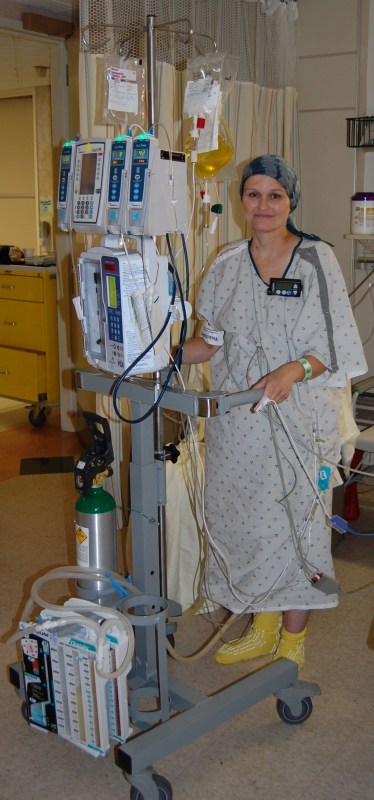
Patient Marcia Smith is able to move around more quickly following her surgery thanks to a new wheeled walker created at Vanderbilt. (photo by Mimi Eckhard)
New walker improves post-surgical mobility
In an effort to improve patient mobility and reduce complications following surgery, Vanderbilt Thoracic Surgeon Jonathan Nesbitt, M.D., has invented a light-weight, wheeled patient walker that carries everything the patient needs, including two oxygen tanks, heart monitor, catheters, chest tubes and IVs.
Previously, at least two nurses and a physical therapist had to help each patient safely maneuver the hospital corridors with the myriad medical devices.
Now, patients can begin their post-surgical exercise regimen on their own.

Jonathan Nesbitt, M.D.
“I was looking for a simple way to improve patient care,” said Nesbitt, associate professor of Thoracic Surgery at Vanderbilt University Medical Center. “It can be very intimidating for patients recovering from major surgery. This walker literally helps patients get back on their feet, faster and safer,” he said.
With sketches in hand, Nesbitt worked with biomedical engineers and a local sheet metal company to create the all-in-one medical walker. Several prototypes later and a patent pending, the latest version features collapsible handlebars and a fold-up seat to allow for periodic rests. The device can be stationed at the bedside, much like traditional IV poles.
When Marcia Smith, a schoolteacher from Decherd Elementary in Franklin County, Tenn., awoke from major surgery to remove a growth from her chest, she was more than overwhelmed by all of the tubes, wires and machinery surrounding her.
But on day two, Smith was walking down the hospital corridors several times a day without assistance, thanks to Nesbitt's invention.
“It wasn't that easy to exercise right after surgery, but the walker gave me a real sense of independence, physically and emotionally,” Smith said. “It felt great knowing that I could do this on my own.”
Physicians have long understood the recuperative benefits of increasing patient mobility.
Getting patients to move more frequently just after surgery can reduce the incidences of serious complications such as blood clots and pneumonia, decrease hospital stays and, ultimately, reduce health care costs.
Nesbitt is currently documenting patient satisfaction with the walker as part of an approved Vanderbilt human research study begun in February.
Already, 30 thoracic surgery patients at Vanderbilt have tried the walker, comparing it to the traditional method of assisted exercise.
And while the response, to date, has been unanimous in its support of the walker, completing the study has proven difficult.
“Once patients try the independent walker, they don't want to go back to the traditional, assisted method,” said Unit Manager Richard Corcoran, B.S.N., “But who can blame them? This is a win-win for all of us.”













